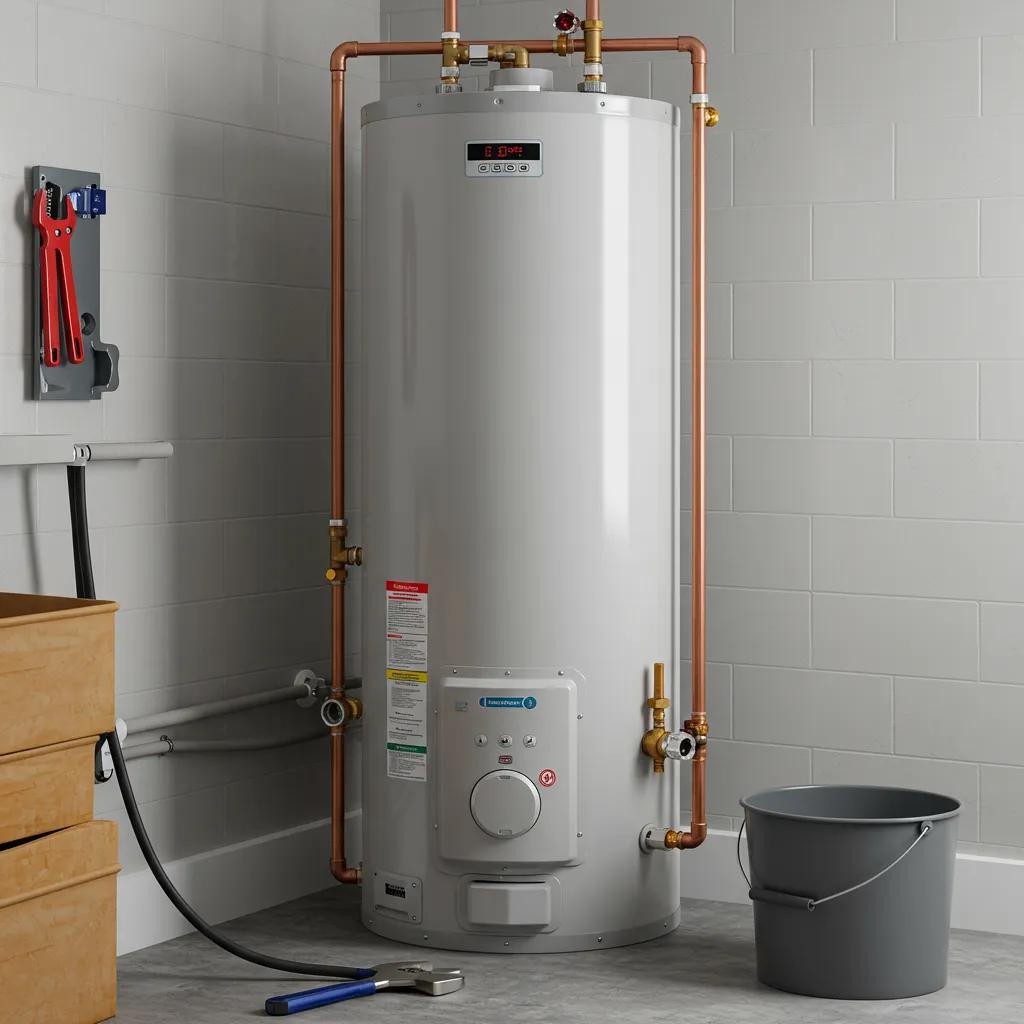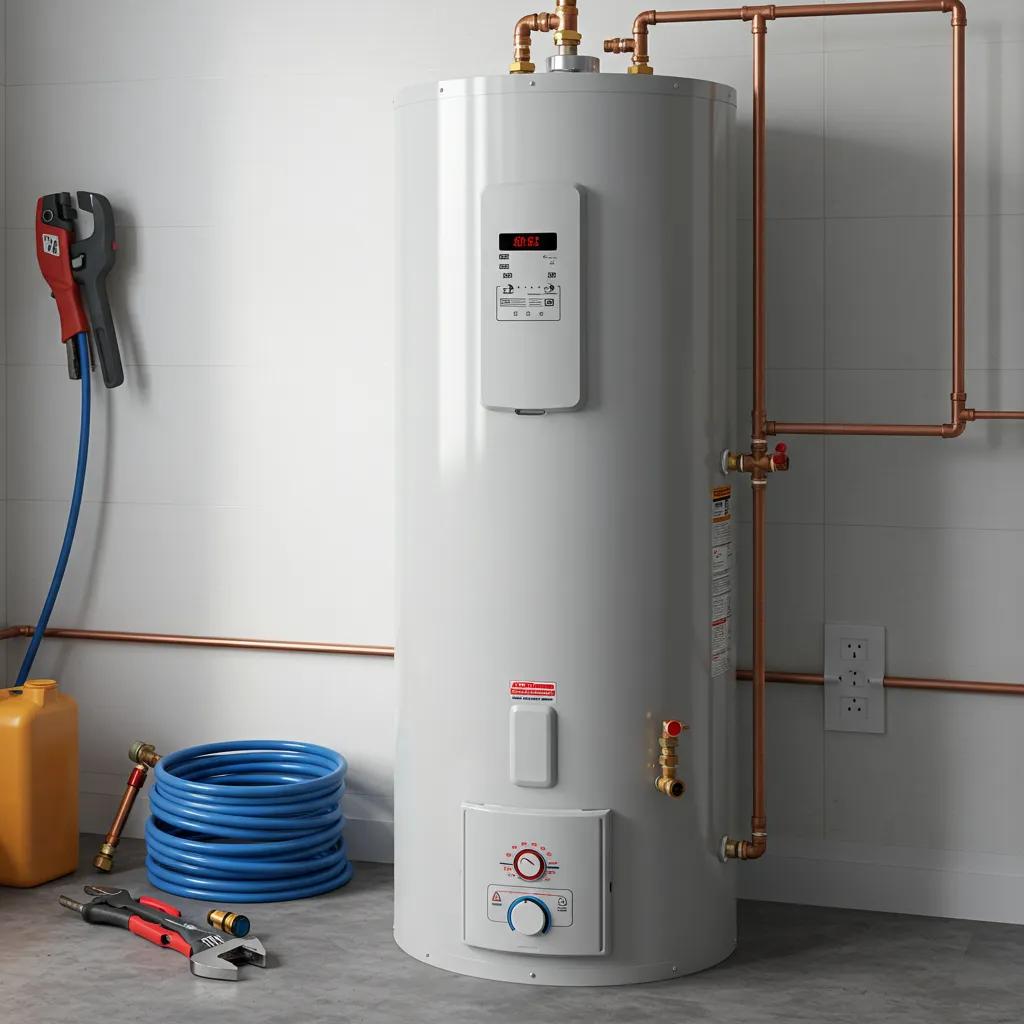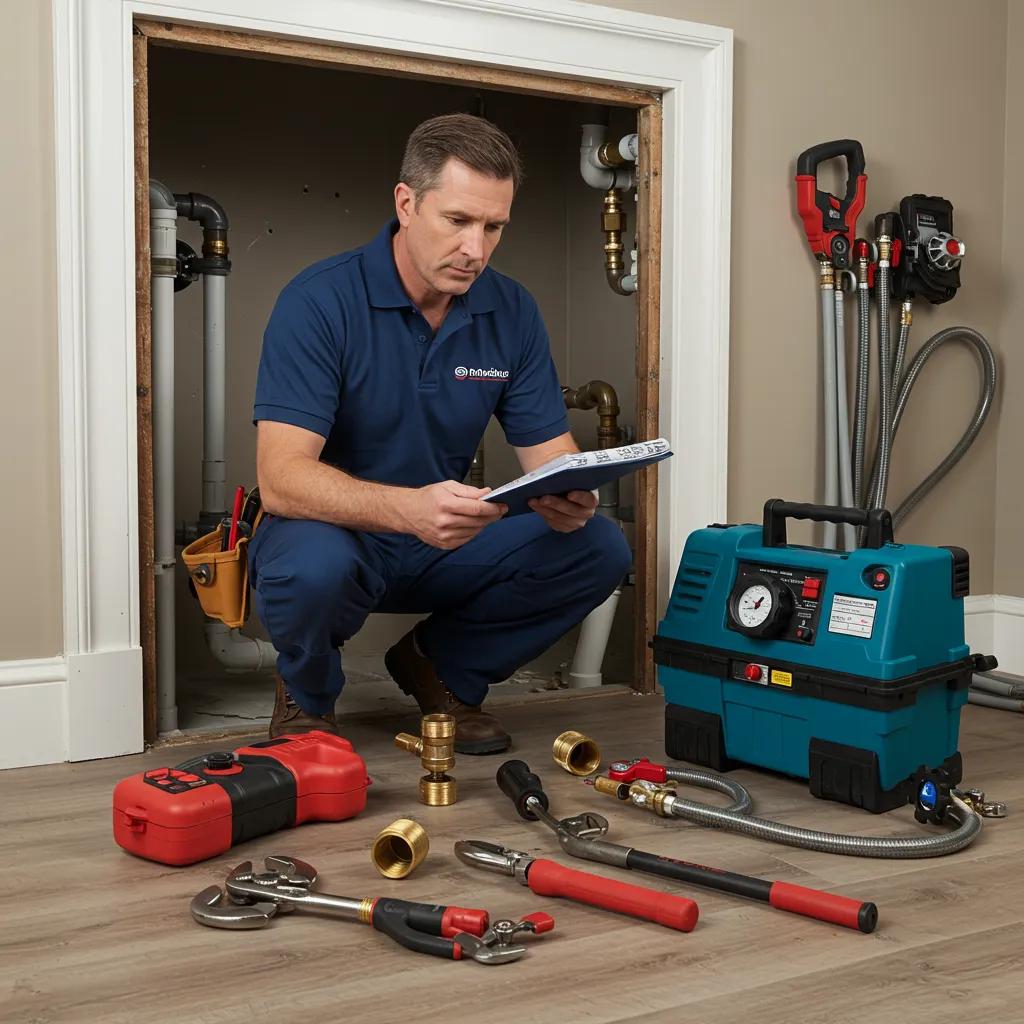Understanding Common Plumbing Noises: What They Mean and How to Respond in Erie, PA
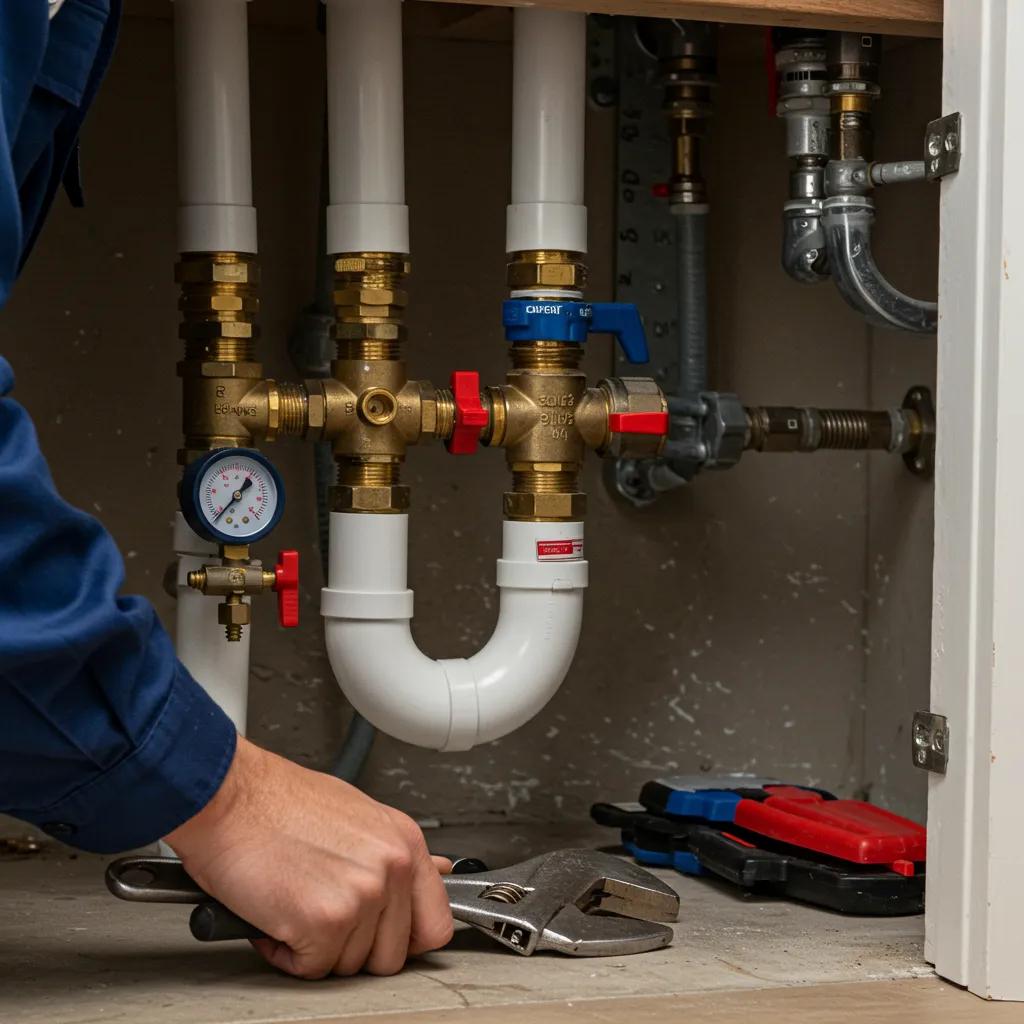
Strange banging, gurgling, whistling, humming or rattling noises from your plumbing often signal underlying issues that can lead to leaks, pipe damage, or water waste if left unaddressed. Learning what should i do if my plumbing is making strange noises and sounds empowers Erie homeowners and business owners to diagnose minor issues and know when to seek professional help. This guide explains the most common plumbing sounds, how to pinpoint their causes with simple home checks, effective DIY fixes and professional solutions, plus local factors like hard water and aging infrastructure that influence noise. You’ll discover when noisy plumbing demands the expertise of licensed technicians at C Carlin Plumbing and how our Erie-based team delivers transparent estimates, emergency response, and quality repairs for lasting quiet.
What Are the Most Common Plumbing Noises and Their Meanings?
Plumbing systems communicate through distinct sounds that reflect pressure changes, flow restrictions or loose components. Recognizing each noise type and its core mechanism helps prevent serious damage before water hammer, clogs or worn parts escalate.
Below is an overview of five typical plumbing noises, their primary causes and diagnostic clues:

Each noise type indicates a different pressure or flow disturbance. Understanding these distinctions leads naturally to targeted home inspections and timely professional intervention.
What Causes Banging Pipes and How Is Water Hammer Involved?
Banging pipes, often called water hammer, occur when rushing water abruptly stops or changes direction, sending a hydraulic shock through rigid piping. This phenomenon stresses joints and can loosen clamps or fittings. Water hammer arises because sudden valve closures create pressure spikes that exceed normal operating levels. For example, a dishwasher or washing machine shutting off quickly may trigger a loud bang. Licensed technicians recommend installing water hammer arrestors or adjusting a pressure-reducing valve to dissipate shock energy and protect the plumbing system. Recognizing this cause sets the stage for examining air-chamber resets and pressure regulation checks in your home.
Understanding and Mitigating Water Hammer in Plumbing Systems
The current research deals with practical studies that explain to the Iraqi consumer multiple instances about the phenomenon of water hammer which occur in the water pipeline operating with pressure. It concern a practical study of the characteristics of this phenomenon and economically harmful to the consumer the same time. Multiple pipe fittings are used aimed to reduce this phenomenon and its work as alternatives to the manufactured arresters that used to avoid water hammer in the sanitary installations, while the consumer did not have any knowledge as to the non-traded for many reasons, including the water pressure decreases in the networks and the use of consumer pumps to draw water directly from the network. Study found a number of conclusions and recommendations of some of the most important pipe fittings have been effective in curbing this phenomenon, as reflected in the illustrations included in the search.
Water Hammer Arresters; Review studies and practical experiments for alternatives, BH Khudair, 2013
Why Do Drains and Toilets Make Gurgling or Bubbling Noises?
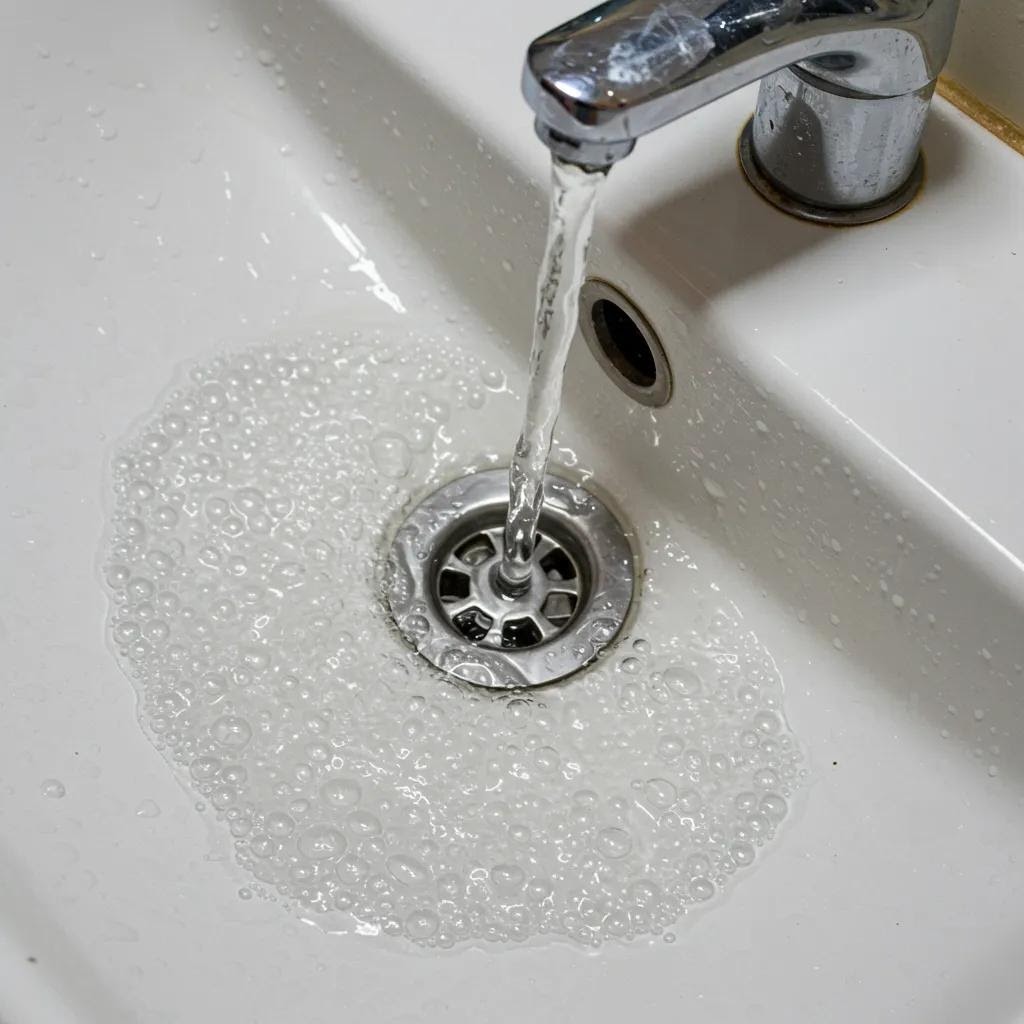
Gurgling or bubbling in drains and toilets signals trapped air or partial clogs interfering with smooth water flow. When vent pipes are obstructed—by debris, bird nests or ice—air cannot escape, forcing it back through fixtures and creating a bubbly sound. Alternatively, a downstream clog in the sewer line can cause intermittent gurgles as water struggles past a narrow passage. A simple way to differentiate is to run water in a sink: if the toilet gurgles, the vent or main line needs clearing. Proper vent maintenance and professional drain cleaning eliminate blockages and restore proper airflow, preventing backup and odor issues.
What Does Whistling or Squealing in Pipes Indicate?
High-pitched whistling or squealing often points to restricted water flow from a worn faucet washer, faulty valve seat or accumulated mineral sediment. Over time, small particles deposit inside cartridge valves or on washer surfaces, narrowing the water channel and increasing velocity around the remaining opening. This creates a whistle as water accelerates past the restriction. Replacing washers, cleaning sediment with a water softener service or installing a pressure-reducing valve restores full bore flow and eliminates noise. Identifying this issue highlights the importance of water quality management and valve maintenance for quiet plumbing.
How Do Humming and Vibrating Pipes Signal Plumbing Problems?
A steady hum or vibration in pipes usually stems from elevated water pressure, loose mounting brackets or resonance within long pipe runs. Pressures above the recommended 60 PSI create turbulent flow through valves and fittings, inducing vibrating frequencies felt throughout the system. Loose pipe straps allow slight movement inside walls or floors, amplifying the hum. A professional pressure test, followed by installing or adjusting a regulator, reduces noise and extends fixture life. Securing loose pipes with vibration-dampening clips completes a comprehensive solution for humming sounds.
What Causes Rattling Pipes and How Can They Be Secured?
Rattling pipes result when conduits shift against joists, studs or ductwork as water starts or stops. Thermal expansion also makes copper pipes pop or clatter against brackets. Loose hangers fail to cushion movement, turning every water usage into noise. Inspect visible pipes for unbraced sections and secure them with padded pipe clamps spaced every 3–4 feet. For thermal expansion, consider adding expansion loops or insulating sleeves around hot-water lines. These measures prevent metal-on-wood contact and maintain quiet operation regardless of temperature fluctuations.
How Can You Diagnose Noisy Plumbing Issues at Home?
Diagnosing plumbing noises begins with simple, safe DIY checks that reveal pressure anomalies, air pockets or blockages without special tools. Start by resetting air chambers, measuring pressure and inspecting visible fittings to distinguish minor maintenance from deeper problems.
First, check for trapped air: turn off the main supply, open the highest faucet and fully drain the lowest fixture to bleed air from the system. Then reopen valves slowly to avoid water hammer. Next, measure static and dynamic water pressure with a gauge at an outdoor spigot; optimal residential pressure is 40–60 PSI. Pressure above 80 PSI often causes humming, vibrating and banging. Finally, visually inspect exposed piping and valve connections for signs of looseness or sediment buildup that correlates with noise events.
What Simple DIY Checks Can Identify Plumbing Noise Causes?
Use a water pressure gauge, a basic clamp meter for vibration, and a flashlight to examine pipe mounts. Resetting air chambers and flushing lines reveals whether sounds stem from air entrapment or mineral deposits. Tightening loose fittings and cleaning aerators offers quick relief. These steps prepare you to decide if further professional diagnosis is needed.
When Is Plumbing Noise a Sign of a Serious Problem?
Persistent bangs, gurgles or rattles accompanied by leaks, drips or reduced flow indicate structural or sewer-line issues requiring immediate attention. Recurring water hammer can crack fittings, while vent blockages may lead to sewage backup. Recognizing urgency avoids costly damage and health hazards.
How Does High Water Pressure Affect Plumbing Noise?
Excessive pressure magnifies noise issues by accelerating water through constricted areas and stressing pipes. It contributes to humming, hammering and premature fixture wear. Regulating pressure at the main supply prevents multiple noise types and protects appliances.
What Role Does Sediment Buildup Play in Noisy Pipes?
Hard water deposits accumulate inside valves, aerators and tanks, narrowing flow channels. This restriction produces whistling and squealing as water speeds past mineral obstructions. Flushing your water heater and using a softener service mitigate sediment-induced noise and maintain system efficiency.
What Are Effective Solutions for Common Plumbing Noises?
Resolving plumbing noise entails targeted fixes that address the root mechanism—whether hydraulic shock, flow restriction or mechanical vibration. Professional water hammer arrestor installation, pressure regulation, valve replacement and pipe securing form a comprehensive toolkit.
Before listing solutions, consider the following table comparing key repair options, their mechanisms and benefits:
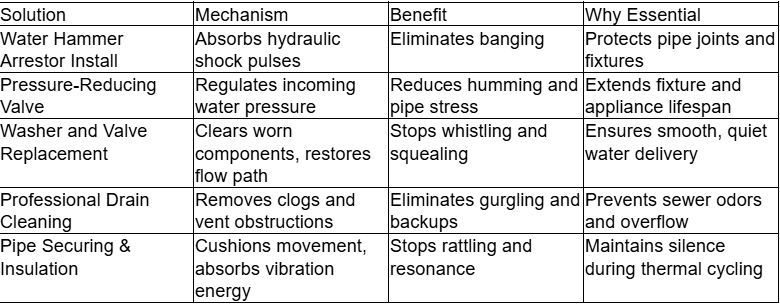
How Does Installing a Water Hammer Arrestor Stop Banging Pipes?
A water hammer arrestor contains a pressurized air chamber or piston that absorbs sudden pressure surges when valves close. By cushioning the shock, it prevents the hydraulic hammer effect that causes violent knocks and joint fatigue. Installing arrestors near high-impact fixtures delivers immediate quiet and long-term protection.
What Are the Best Ways to Clear Gurgling Drains and Vent Blockages?
Effective drain cleaning combines mechanical cable augers, hydro-jetting and vent pipe inspection to remove hair, grease, mineral scale and debris. Professionals use camera diagnostics to pinpoint blockages, ensuring thorough clearance that stops gurgling and prevents recurrent backups.
How Can Worn Washers and Faulty Valves Be Repaired to Stop Whistling?
Replacing deteriorated rubber washers and cleaning or swapping out valve seats restores the full bore water channel. Mineral scaling is removed via soaking in a mild descaling solution. These repairs remove flow restrictions that generate high-pitched noise.
What Steps Reduce Humming and Vibrating from High Pressure or Loose Fittings?
Adjusting or installing a pressure-reducing valve to maintain 40–60 PSI halts turbulence-induced vibration. Securing loose pipe straps with vibration-dampening clips stops resonance against framing. These measures silence humming and extend component life.
How Is Pipe Insulation Used to Minimize Rattling Noises?
Wrapping pipes in foam insulation or neoprene sleeves creates a buffer between metal and wood surfaces. Insulating clips hold conduits securely while damping thermal expansion noises. Proper coverage eliminates rattles and maintains even temperature distribution.
When Should You Call a Professional Plumber for Noisy Pipes in Erie, PA?
Minor noises may resolve with DIY checks, but many plumbing sounds signal underlying risks that require expert diagnosis. Knowing when to call licensed technicians ensures timely fixes that prevent water damage, structural harm and health hazards.
Persistent banging, repeated gurgling after vent cleaning, sudden whistling at all fixtures or vibrating pipes behind walls usually exceed homeowner repair scope. Emergency leaks, sewer backflow or noises accompanied by damp spots demand immediate professional response. C Carlin Plumbing delivers 24/7 emergency services, leveraging 30 years of local expertise to diagnose complex sounds, deploy specialized equipment and restore quiet operation.
What Plumbing Noises Require Immediate Expert Attention?
Loud water hammer that persists after an air-chamber reset, sewage-line gurgles, continuous high-pitched squeals in multiple fixtures or vibration accompanied by leaks all require licensed intervention to avoid pipe bursts or contamination events.
Why Is Professional Diagnosis Important for Complex Plumbing Sounds?
Complex noises often involve hidden components—underground sewer lines, concealed vent stacks or inaccessible manifolds. Professional camera inspections, pressure tests and digital vibration analysis locate issues precisely, ensuring repairs address root causes rather than temporary symptoms.
How Does C Carlin Plumbing Provide Emergency and Reliable Noise Repairs?
Based in Erie County, C Carlin Plumbing deploys licensed technicians equipped with diagnostic cameras, hydro-jetters and pressure gauges to resolve noise issues rapidly. Transparent estimates and quality materials back every repair, giving customers confidence in lasting quiet and system integrity.
How Does Local Water Quality and Erie Home Infrastructure Affect Plumbing Noises?
Erie’s moderately hard water contains dissolved minerals that deposit inside pipes and fixtures, increasing sediment buildup and accelerating wear on washers and valves. This local water chemistry often leads to squealing, whistling and reduced appliance lifespan.
Older Erie homes commonly feature galvanized or outdated copper piping with loose brackets and vent designs no longer code-compliant. Thermal expansion in these systems causes frequent rattling and clattering against wooden framing. Understanding these local infrastructure factors informs targeted solutions like water softening, pipe re-securing and code-approved vent upgrades that silence noises and modernize aging plumbing networks.
How Does Hard Water in Erie Contribute to Sediment and Pipe Noise?
Calcium and magnesium precipitate out when water heats or accelerates through valves, forming scale inside faucets and heater tanks. This narrowing of flow paths produces high-pitched noise and reduces hydraulic efficiency. Regular descaling and softener installations mitigate these effects and prevent whistling.
What Plumbing Noise Issues Are Common in Older Erie Homes?
Historic residences often have undersized vent stacks with sharp elbows, undersupported piping with minimal bracing, and inadequate air chambers. These conditions provoke gurgling, banging and thermal expansion sounds. Retrofitting modern components and reinforcing supports remedies these persistent noise sources.
How Do Local Regulations Influence Plumbing Noise Solutions?
Erie County plumbing codes specify minimum vent sizes, trap arm lengths and mounting standards that suppress noise and ensure proper drainage. Licensed professionals adhere to these regulations when installing arrestors, regulators and vent upgrades, guaranteeing compliance and sustained quiet operation.
What Are Frequently Asked Questions About Plumbing Noises?
Homeowners often wonder which sounds are harmless and which demand repair, how to distinguish pressure issues from blockages, and what preventive maintenance prevents recurrence. Common concerns include whether noisy pipes pose a danger, if DIY fixes are sufficient, and how much professional repairs cost. Understanding these questions in narrative form guides readers toward informed decisions and emphasizes value of timely expert intervention.
Why Choose C Carlin Plumbing for Plumbing Noise Diagnosis and Repair in Erie, PA?
C Carlin Plumbing combines over 30 years of local service with licensed technicians trained in both plumbing and HVAC diagnostics. Our team’s expertise in hydraulic shock mitigation, vent system restoration and sediment management ensures precise noise diagnosis and effective long-term repairs. Transparent estimates with no hidden fees build trust, while comprehensive emergency services guarantee fast response to urgent situations. From installing water hammer arrestors to performing professional drain cleaning and pressure regulation, we deliver solutions that enhance system performance and silence disruptive noises. Experience the confidence that comes with Erie’s trusted plumbing partner—contact C Carlin Plumbing for reliable, expert noise resolution today.
Quiet, efficient plumbing begins with accurate diagnosis and targeted repairs. Addressing unusual sounds promptly not only restores comfort but also protects your home’s infrastructure and preserves water resources. Trust C Carlin Plumbing’s licensed experts to bring lasting silence to your Erie property.

